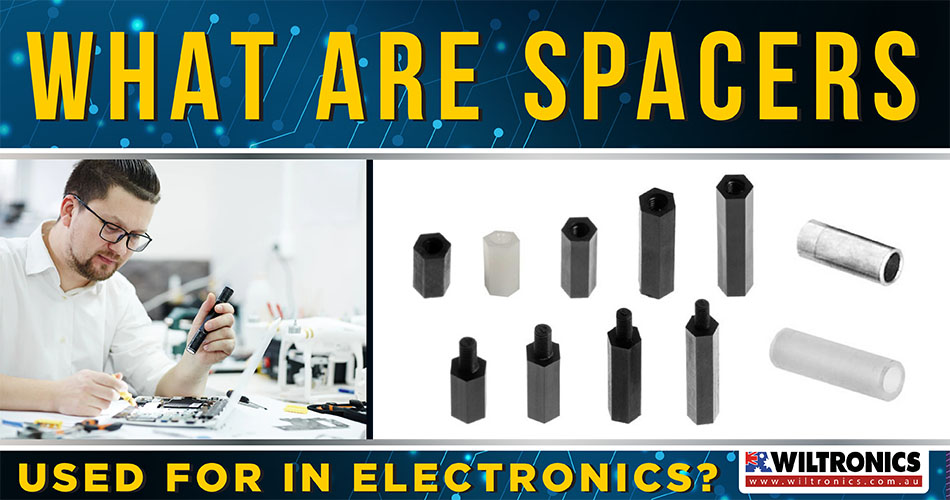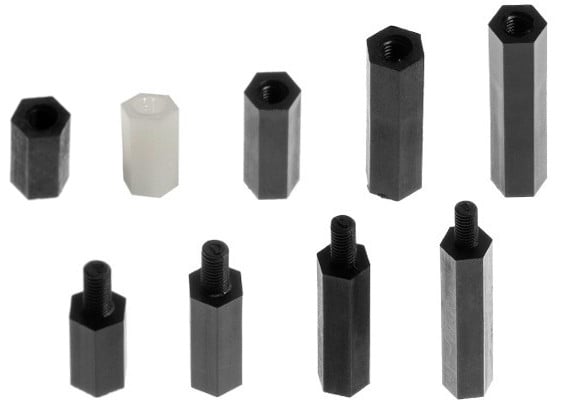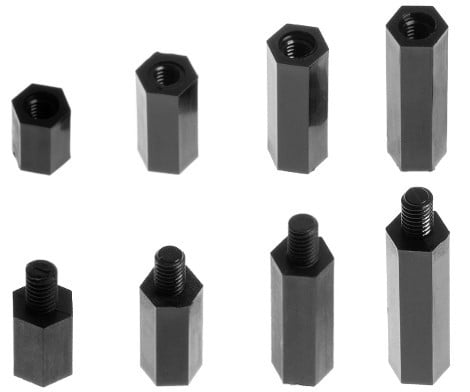What Are Spacers Used For in Electronics?
October 21, 2022

The term ‘spacers’ is widely used in many industries, all of which have different roles. In engineering work, they are an important type of fastener accessory.
Paired with standoffs, they keep one component off another—ideal for assembly tasks. You might have to use them at some point, and this guide will come in handy.
All the basic information you will need is here!
Spacers Explained
Spacers, also known as spacer bolts or spacer rods, are small fastener elements. They fix and position fastening components, ensuring distance is maintained.
They are screw-like when it comes to size and are commonly round, square or hex shaped.
Spacers in hexagonal material offer easy assembly using a clamping tool, e.g. a wrench. For square and cylindrical versions, spacer bars are also offered with a spanner flat.
They are used in many industrial sectors, such as in measurement technology. Materials available include aluminium, steel, titanium, or nylon.
Spacers can also have threads: male to female, female to female and male to male. These allow them to be connected to a component to provide a lifting and separating function. Other versions are hollow.
Distance pieces
A distance piece, also referred to as a spacer sleeve, has no thread and is cylindrical. Generally, it is used to lift or separate components from each other.
But it can also be utilised for other applications like guiding bolts, cables and screws. Available in a variety of sizes and materials adapted to the respective application.
How Do They Work?
The hollow body of the spacer allows the shaft of a screw to pass completely through it. This forces a gap to be kept between the screw head and the component below.
At the same time, it allows the fastener to be properly torqued. This ensures the screw or bolt remains and cannot be driven all the way in.
Most have a smooth interior and will remain free-spinning until clamped in place. Spacers are usually made of metal, but for certain jobs, consider other materials.
Nylon, for one, is a common choice for non-conductive electrical works.
The Difference Between Standoffs
Many often use the terms spacers and standoffs interchangeably. But the two are actually designed and utilised differently.
One of their main differences is that standoffs are threaded at each end, while spacers are not. Standoffs are used to raise one assembly above another, whereas spacers separate them.
This threading is gendered. This means it can either be male (protruding) or female (internal).
Like spacers, available gender combinations for standoffs are male-male, female-female, or male-female. Moreover, standoffs are usually round or hex-shaped to enable wrench-tightening.
In electronics, they are used to raise a printed-circuit board above a surface. As for the materials, they are often made using aluminium, brass or nylon.
Insulating standoffs can keep two parts from touching each other, preventing electrical shorts. When used to fasten cable connectors, e.g. “D”, together, they are called jack screws.
Spacers are quite different from standoffs when it comes to function and design. As mentioned, they are unthreaded pieces of tubing that accommodate the entire bolt.
But their interiors can be threaded or smooth. And like standoffs, the exteriors can be round, hex, or knurled.
Spacers are designed solely to maintain spacing between components. For instance, a bolt running through the centre of the space needs to be fastened. They are often used for bundling small wires together, to boot.
How spacers and standoffs are used?
Despite their differences, spacers and standoffs make the perfect combination for electrical assembling. This includes circuit boards, gears, panels, and other electronic components.
A common use of both is in computing, e.g. motherboard standoffs are inserted between a PCB and the chassis. This aids cooling around the motherboard and its mounted components.
Plus, it helps avoid short circuits. For instance, when motherboard traces come into contact with other metallic parts or surfaces.
When it comes to spacers, they are particularly used for mounting hardware. They allow for enough gaps left for airflow and cabling.
As a result, this helps achieve more precise positioning of screws and bolts. Some bolt spacers also ensure the screw-in connections are more robust.
When using these fasteners for a certain job, there are four main factors to consider:
- The shape of the spacers or standoffs
- Body diameter or the outer width
- Body length
- Hole clearance width or thread size (inner diameter)
- Gender of the threading at each end
Different Types of Spacers
In the following sections, the basic options for spacers are outlined. These include shapes and materials.
Shapes
Round spacers
Round spacers have a less industrial look than hex or square versions. They are cylindrical and with a smooth exterior for a clean, finished look.
They slide over bolts or screws to maintain space between components in assemblies. Plus, they provide clearance when installing or mounting objects.
Hex spacers
Hex spacers are hexagonal, with flattened sides to help with torque. They can be gripped by a wrench to hold the spacer in place and prevent turning or twisting during assembly.
The hex shape also allows fine adjustments to the spacer after fastening. Hex spacers are ideal for internal uses that will be hidden from view, i.e. behind panels or in cases.
For one, they are less aesthetically pleasing than round spacers.
Materials
Brass
Brass makes these spacers electrically conductive, and the zinc-plated finish adds corrosion resistance. This spacer type is heavier and more robust than most aluminium versions.
Stainless steel
Stainless steel spacers are used in assemblies where optimal corrosion resistance is vital. Ideal for visible mounting solutions as they remain looking pristine for extended periods.
Tubular steel spacers are heavier and more durable. And often more expensive than aluminium equivalents.
Aluminium
Aluminium spacers are a cheap, lightweight and durable alternative to the previous two. Ideal for cutting and applications with the highest weight-to-strength ratio.
They cope well as an insulator and in high-temperature applications.
Ceramic
Ceramic spacers provide impressive insulating properties and can withstand high temperatures. They may be essential where non-conductive performance under severe temperature loads is needed.
They especially come in handy in certain industrial or mechanical settings.
Nylon
The best choice where complete electrical insulation is needed. Nylon spacers offer the ideal non-conductive properties of all the available materials.
Despite their overall strength, they are incredibly lightweight. But keep in mind that they can be prone to shearing in high torque installations.
Although highly chemical resistant, they are less suitable in damp or humid environments. For one, this type tends to absorb moisture over time.
Nylon spacers applications
Safe for use in both outdoor and indoor applications, such as:
- Automotive
- Construction
- Electrical
- Electronic equipment
- Fabrication
- Furniture
- HVAC
- Manufacturing
- Marine
- Military
- Security
- Vending/ATM
- White goods
Get Your Nylon Spacers Here!

M3 Nylon Spacers Pack of 10
Product code: HA103x
These M3 nylon rods are available with male/female ends or female for both ends. Plus, in 10mm, 15mm, 20mm, or 25mm lengths.
Sold in a pack of ten (10). All are black in colour except the 100mm: female-female is white.

M4 Nylon Spacers Pack of 10
Product code: HA104x
These M4 nylon spacers are available with male/female ends or female for both ends. Plus, in 10mm, 15mm, 20mm, or 25mm lengths.

Nylon Spacers – 3mm of Clearance
Product code: HA003/4
These round-shaped nylon bolts allow a constant gap between 2 components. They have 3mm of clearance – available in 12mm, 15mm, and 20mm in length and come in a packet of 8 or 100 for each length.

Untapped Spacers – 3mm of Clearance
Product code: HA006/7
This type suits hobby and construction applications. Available in 6mm, 9mm, 12mm, and 25mm in length and packets of 8 and 100 for each length.
The Bottom Line
Spacers are small enough to fit small gaps or spaces between objects, but there is more. They can provide a level surface, offer support, and prevent wear & tear between objects.
Depending on the application, nylon may be a great option to go with.
© Electrotech Brands Pty Ltd 2022


Write a Comment
You must be logged in to post a comment.